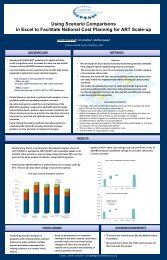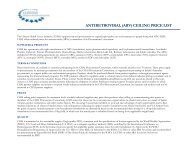HIV/AIDS in Ethiopia: - Clinton Health Access Initiatives
HIV/AIDS in Ethiopia: - Clinton Health Access Initiatives
HIV/AIDS in Ethiopia: - Clinton Health Access Initiatives
Create successful ePaper yourself
Turn your PDF publications into a flip-book with our unique Google optimized e-Paper software.
ETHIOPIA<strong>HIV</strong>/<strong>AIDS</strong> LANDSCAPETHE RELATIONSHIPCHAI-ETHIOPIA AND UNITAIDIn <strong>Ethiopia</strong>, there are currently 1.2 millionpeople liv<strong>in</strong>g with <strong>HIV</strong>/<strong>AIDS</strong> (PLWHA). Ofthose, roughly 760,000 live <strong>in</strong> urban areas.Compris<strong>in</strong>g 2.4% of the total adult population(ages 15 – 49 yrs), the prevalence of <strong>HIV</strong> islower than many countries <strong>in</strong> sub-SaharanAfrica. Notwithstand<strong>in</strong>g, the disease still<strong>in</strong>flicts a substantial burden on the localway of life—at present, nearly 400,000PLWHA require antiretroviral therapy. 1<strong>Ethiopia</strong>’s size <strong>in</strong> population and landmass,ethnic diversity, economic productivityand resource availability create immensechallenges for treat<strong>in</strong>g <strong>HIV</strong>/<strong>AIDS</strong>.Geographically, <strong>Ethiopia</strong> is the eighthlargest country <strong>in</strong> Africa and its populationof approximately 90 million people—comprised of over 80 different ethnicgroups—makes it the second most populouscountry <strong>in</strong> sub-Saharan Africa. The countryis divided <strong>in</strong>to n<strong>in</strong>e ethnically based regionalstates and two city adm<strong>in</strong>istrations,which are further separated <strong>in</strong>to 103zones, 800 woredas (districts) and 15,000kebeles (communities). The vast majorityof <strong>Ethiopia</strong>ns live <strong>in</strong> rural areas and itspopulation is the 9th fastest grow<strong>in</strong>g <strong>in</strong> theworld with an annual growth rate of 2.6%.<strong>Ethiopia</strong>’s <strong>Health</strong> Sector DevelopmentProgram (currently <strong>in</strong> Phase IV) outl<strong>in</strong>ed astrategic plan for combat<strong>in</strong>g <strong>HIV</strong>/<strong>AIDS</strong>, whichhas led to a robust expansion of the exist<strong>in</strong>ghealthcare <strong>in</strong>frastructure and improvedprotocol. While the spread of <strong>HIV</strong> cont<strong>in</strong>uesto grow—over 123,000 adults and 14,000children were newly <strong>in</strong>fected <strong>in</strong> 2010—the<strong>Ethiopia</strong>n government, <strong>in</strong> collaborationwith myriad partner organizations, havecommitted vast resources <strong>in</strong> an effort tocurb the spread of the disease and aid <strong>in</strong>the plight of those already <strong>in</strong>fected. 2In 2006, CHAI was selected as the leadimplement<strong>in</strong>g partner for UNITAID and begandirect<strong>in</strong>g the procurement and supply ofpediatric and 2nd l<strong>in</strong>e <strong>HIV</strong>/<strong>AIDS</strong> commoditiesworldwide. Globally, UNITAID-f<strong>in</strong>ancedand CHAI-implemented <strong>HIV</strong> programsprovide essential health commodities to 40beneficiary countries. In <strong>Ethiopia</strong>, the CHAIhas worked closely with the Federal M<strong>in</strong>istryof <strong>Health</strong> to <strong>in</strong>crease access to care andtreatment for people liv<strong>in</strong>g with <strong>HIV</strong>/<strong>AIDS</strong>,focus<strong>in</strong>g specifically on two areas requir<strong>in</strong>gspecial attention—pediatric ART scale upand adult 2nd l<strong>in</strong>e therapy.S<strong>in</strong>ce June 2007, through its Drug <strong>Access</strong>and Nutrition program, CHAI-<strong>Ethiopia</strong> beganprocur<strong>in</strong>g 100% of <strong>Ethiopia</strong>’s pediatricand adult 2nd l<strong>in</strong>e <strong>HIV</strong> medic<strong>in</strong>es, as wellas a number of additional commoditiesrelated to the diagnosis, treatment andcare of children requir<strong>in</strong>g ART. Thesesupplementary commodities <strong>in</strong>clude: Readyto use therapeutic food, (also known by itsbrand name, Plumpy’nut), for the treatmentof severe acute malnourishment <strong>in</strong> children;Co-trimoxazole, a prophylactic aimed atprevent<strong>in</strong>g opportunistic <strong>in</strong>fections <strong>in</strong> <strong>HIV</strong>weakened immune systems; and laboratorydiagnostic equipment, essential <strong>in</strong> the processof early detection and effective treatment of<strong>HIV</strong>/AIDs.UNITAID, procured a total of $14,785,539USD worth of these commodities betweenJune 2007 and May 2011. At the end of2011, CHAI-<strong>Ethiopia</strong>’s Drug <strong>Access</strong> andNutrition program will phase out, hand<strong>in</strong>gover its activities to appropriate governmentcounterparts and partner organizations.Cont<strong>in</strong>ued fund<strong>in</strong>g for these commoditieshas been secured through The Global Fundto Fight <strong>AIDS</strong>, Tuberculosis and Malaria.Source: 1 ETHARC 2010 National Factsheet sourc<strong>in</strong>g S<strong>in</strong>gle Po<strong>in</strong>t <strong>HIV</strong> Prevalence Estimate, Federal <strong>HIV</strong>/<strong>AIDS</strong>Prevention and Control Office (FHAPCO); 2 UN<strong>AIDS</strong>5 CHAI and UNITAID <strong>in</strong> <strong>Ethiopia</strong>6




